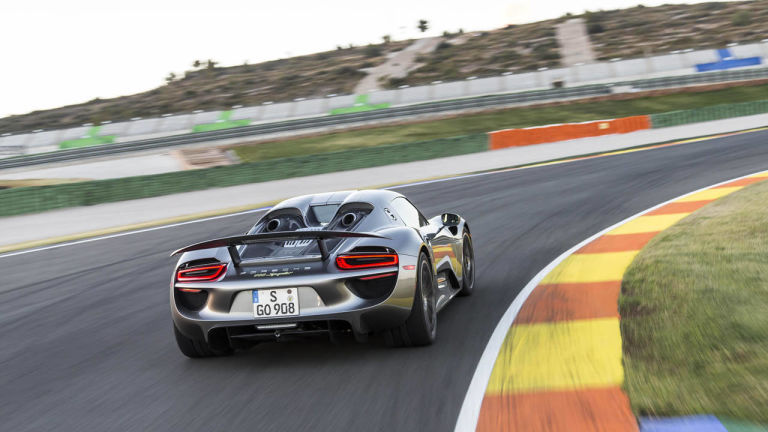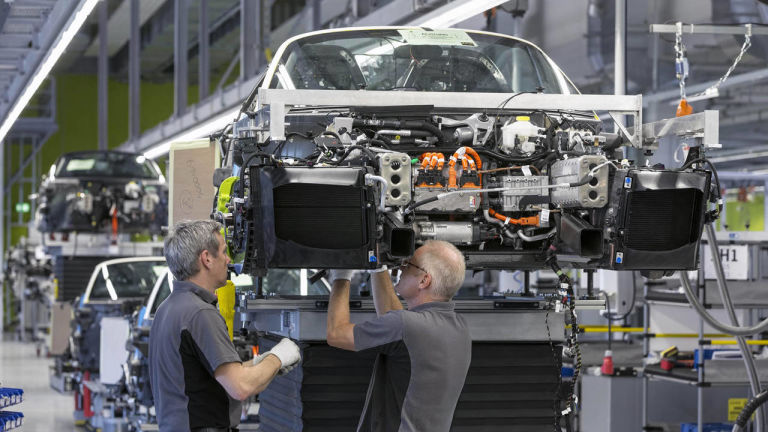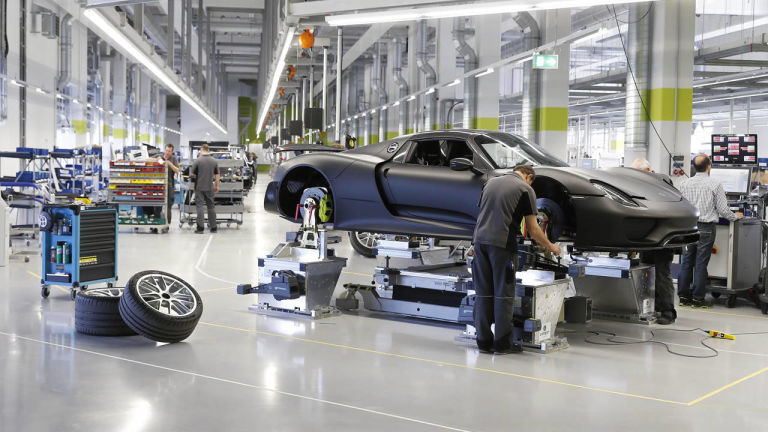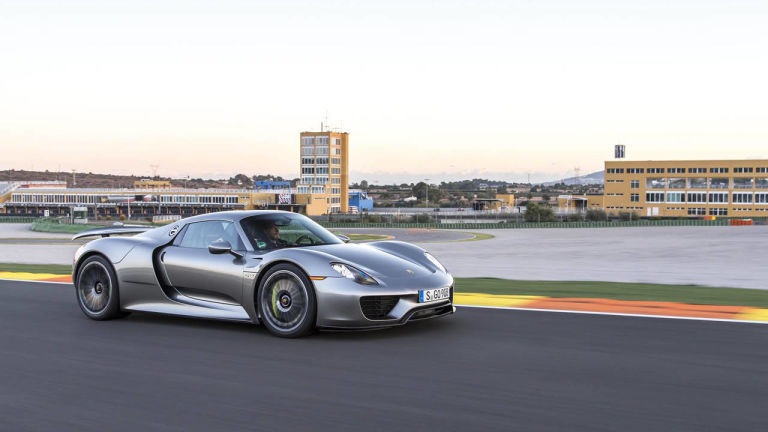Must Watch: Amazing Video of the Porsche 918 Spyder Being Assembled
As we pass through the Porsche 911 production line in Zuffenhausen, Germany, on our way to see where the 887-hp, plug-in-hybrid 918 Spyder is assembled, our tour guide informs us that very few media have seen the process. Tours generally are reserved for prospects, VIPs, and confirmed customers. We fall into the VIP category, or at least that’s what we were told; we certainly lacked the velour jacket of the presumed customer we spotted on another tour.
The 918’s final assembly takes place in one room that formerly served as a 911 paint shop. To get there, we duck into a stairwell and follow an acid-green line—the same color that adorns the brake calipers of all Porsche hybrids—to the second floor of the facility. If you didn’t know what to look for, the entrance could easily be overlooked. We’re sure many standard factory tours never even mention the place at all.
Entering the room, the hybrid-green theme continues. The walls at the ends of the rectangular room are painted green, and green stripes appear above head height on the structural columns. The floor is spotless, save for taped outlines that indicate where carts and parts bins go. The loudest single sound in the whole place is made by squeaking tires on the gloss floor when a freshly birthed 918 is taken to an elevator on its way toward validation. This occurs after it’s been aligned and corner-weighted—genuine race-car stuff.
Now that the scene has been set, here are 15 of the most interesting facts, tidbits, and pieces of intel that we learned:
1. There are 110 workers in total, on a single shift. If Porsche wants, as many as four cars can roll off the line each day. There are 15 primary final-assembly stations, each one given 111 minutes to complete its task.
2. Only two 918s have left the factory without paint of any kind.
3. The Weissach package, an $84,000 option, comes standard with a wrap and paint underneath. But wraps do not have the longevity of clear-coated paint and Porsche made sure the buyers understood that a wrap replacement might be necessary.
4. There are no air-powered wrenches on the line, a first for Porsche. This serves two purposes. First, it makes for a quieter work environment. Second, there are no air hoses hanging around the car, reducing the chance of inadvertent damage to the body or paint. Porsche can also keep track of which bolts were tightened to what level of torque via Bluetooth communication. Note the different torque specs written on each tool above (these are interior trim tools).
5. A fully dressed engine (there are no accessory drives) weighs 309 pounds, about 220 pounds fewer than a 911 engine. Those headers are made of Inconel, an alloy that maintains its strength at high temperatures. There is no way to see this much of the engine once the car is assembled. All engines are dynoed and verified before installation. The heat treatment of hot exhaust gases permanently changes the color of the headers; they will never look this uniform again.
We can only dream about our next engine-assembly project turning out this clean and organized.
6. Each sun visor has 200 hand-stitches and requires 45 minutes to complete. The sun visor’s core is made of Styrofoam. With the exception of the seats and steering wheel, all leather fitting is done in the final-assembly room. The leather work in a 918 takes three times more man-hours to complete than does that of a 911.
7. The backing for the leather-wrapped interior surfaces is either a lightweight wood composite (like MDF) or carbon fiber.
8. The titanium screws included in the Weissach package are ten times the cost of the steel bolts but weigh 60-percent less. They are used to attach subframes and the suspension control arms.
9. The A/C compressor lives behind the front-mounted electric motor in a magnesium casting. Note the pewter-colored cap on the top of the coil-over assembly; this is the optional front-axle lift system. A car without this convenience is in the background.
10. Six bolts are used to marry the carbon-fiber tub and the powertrain’s carbon-fiber substructure. This substructure carries the 4.6-liter V-8, rear electric motor, and seven-speed dual-clutch automatic.
11. Due to limited supplies of some of the Weissach package’s pricier parts, such as ceramic wheel bearings and the carbon-fiber rear anti-roll bar (seen above with the standard model’s steel unit), only seven of the Weissach cars can be produced per week.
12. Unlike most production lines, there is no fuel stop during 918 assembly. Once outside these walls, a 918 will not drive with an empty fuel tank (two of them are pictured above), but there is a special mode that enables the car to maneuver under electric power in the factory before fuel is added to the tank. This saved some complexity—mostly in safety infrastructure—when preparing the old paint shop for operation as an assembly line.
13. Aside from some fasteners, there isn’t much steel in the 918. What little there is includes the door beams seen here.
14. The honeycomb-laden engine cover (which features exactly 7436 hexagons) costs more than the painted body of a Panamera sedan.
15. The red padlock in the passenger footwell prevents the high-voltage battery from being connected. This keeps the workers out of harm’s way, electrically speaking.
click on read more to see
5 things I learned while driving the $845,000 Porsche 918 Spyder
Deadly cars just aren't built anymore.
Even if the Carrera GT was a killer—and it most emphatically was not—the science of carmaking has evolved. The 918 produces 887 hp and 944 lb-ft of torque. It tops out at a whopping 214 mph. It locates much of its mass in the middle of its chassis, where supercars have for decades, and it produces far more power than most people can handle. Unlike the traction-control-only Carrera GT, it has both traction and stability control standard because both are required by law in America.
But this is different. Yes, stability control is there to save you if you're a bonehead. But this has to be the most civilized 944 lb-ft on the planet. The monster torque is always predictable. The engine's righteous pull never catches you off guard. Around town, the car is quiet and relaxed when you want
it, loud and angry when you don't. It rides well. Stability control doesn't intervene unless you drive like a jerk. And, most importantly, the car has both the balance and the chassis tuning to be approachable for novices. It feels like a balanced all-wheel-drive sports car because it is, but its reflexes and track behavior carry few of the configuration's traditional drawbacks.
The weirdest thing is that none of this is surprising. Think about that for a second. We live in an era where a manageable 944 lb-ft of torque is something like ordinary. Where journalists are piled off a plane onto a race track they've never seen and an 887 hp car they've never driven for quick lapping, and no one bats an eye from worry. Where something like the Carrera GT—a machine that demands respect, but far from a killer—can be demonized simply because it isn't idiot-proof. Progress is a funny thing.
it, loud and angry when you don't. It rides well. Stability control doesn't intervene unless you drive like a jerk. And, most importantly, the car has both the balance and the chassis tuning to be approachable for novices. It feels like a balanced all-wheel-drive sports car because it is, but its reflexes and track behavior carry few of the configuration's traditional drawbacks.
Speed is relative.
One of the journalists on my wave of the 918's press launch was Daytona and Le Mans winner David Donohue. Two things about this: One, his father, Mark, was a racing legend who did development work on both the Porsche 917/10 and 917/30. Mark Donohue is one of my heroes, and David's no slouch. And two, after climbing out of the car, David passed on a quote from former Brumos teammate Hurley Haywood. I don't remember the exact wording, but it was something like, "Fast is relative to what you're driving."
Even the slowest and most timid of the journalists at the 918 launch cranked down the track's front straight at 160 mph. At 160 mph, a 918 does not feel fast. It feels like it's barely moving; the way a Camry feels at 55 mph. This is part aero tuning, part chassis genius, and it's thoroughly expected. In the supercar world, it's far from rare. But that doesn't mean you're not gobsmacked when you see it.
It marks a sea change in how cars are built.
Everyone will say it, but few will actually consider what it means: This is a revolutionary car. I spent a lot of time talking to the 918's engineers about the problems they encountered during development. Most of them can be summed up in the phrase, "And then we solved that, but man, it was a pain in the
ass." This is normal with new car development, though admittedly not in such quantity.
More telling was the fact that half of the technology on display couldn't be easily explained by the engineers who built it. It wasn't a language or knowledge barrier; this is a group of guys who are fluent in English, some of the smartest and most resourceful engineers on the planet. I've been on a lot of Porsche launches, and these dudes aren't easily stumped. They're used to making complex concepts understandable for people with a decent tech background but no master's degree in engineering (read: your author). I lost count of the times one engineer had to grab another engineer to help him explain how something worked. Or when one of the guys had to shrug and say, "I'm not sure."
The Carrera GT was a stake in the ground, and there's no denying its significance in the supercar pantheon. But it was essentially a roadgoing Le Mans prototype; racing technology adapted sensibly for the road. Most of its innovations lay in materials science. The 918 isn't a race car and wasn't intended to be one; moreover, race cars are no longer the street car proving ground they once were. This was an effort to make a rewarding, efficient, fast car that fell outside the traditional mold—heavy, hybridized, and purposefully complex instead of purposefully simple. And it worked.
Like the 959, the 918 is a conscious effort to advance the science of the automobile in every way possible. It's a machine built solely to push the envelope. And thirty years from now, we'll see more of the 918 in street cars than we will the Carrera GT.
ass." This is normal with new car development, though admittedly not in such quantity.
Porsche's greatest talent is in making the extraordinary ordinary.
By definition, supercars aren't everyday things. They almost always ship with caveats, small or large issues that prevent them from being as usable or practical as your daily commuter. Owners overlook this stuff because of what they get in return. Unless they buy Porsches. At which point there's very
little to overlook.
For all its talents, the 918's greatest party trick is akin to that of the 911—or the 959, or the Panamera Turbo. It gets out of the way. Save the massive whonk the engine makes when it lights off, the hybrid system is nearly seamless. It feels small and practical in traffic despite being roughly as wide as a city bus. Getting in and out isn't easy, but it's easier than it was in the Carrera GT and easier than doing the same with a Ferrari Enzo. There is almost no trunk space, but you could say the same about a Carrera GT.
I've driven a lot of high-dollar exotics. Almost all of them have one thing in common: They never stop reminding you that you're in something crazy. The 918 reminds you, then quietly shuts up and lets you go about your business. You have a good time, and if you want the crazy again, you get that, too. And that's an achievement in itself.
little to overlook.
The state of the art is holy-hell-crazy-pants-impossible fast.
The best way to illustrate the 918's speed potential is to describe what happened on the press launch. And to talk about the 2014 911 Turbo S.
The '14 Turbo S is as fast as unholy snot. It produces 560 hp and 553 lb-ft of torque. Porsche claims the car can sprint to 60 mph in 3.1 seconds—just a few tenths slower than a Bugatti Veyron—and early tests indicate the car circles a skid pad around or slightly above 1.0 g. You stand on the throttle in that thing, and the earth reverses its rotation and spits your spleen into your spinal column.
There was a Turbo S at the media drive. It was driven by Porsche test driver Timo Kluck, an affable dude with a driving resume a mile long. Each journalist got seven laps in the 918 playing chase to Kluck in the 911. And two laps in, almost all the journalists present had to lift to avoid running Kluck
over.
This is not a statement about the driving talent of the average journalist. Far from it; journalists aren't known for being decent drivers. (Ahem! Except yours truly, who is a super genius in everything hedoes.And also incredibly attractive and modest.) And Kluck is a pro. But it speaks
volumes about the 918's insane thrust and eye-sucking grip.
Kluck was on the ragged hairy edge in the Turbo S, one of the fastest street cars on the planet. He was skittering over the limit and generally driving the wee out of the car. And the 918 might as well have been driven by a dead hamster for all it took to keep up. You can knock the 918 for weighing close to
two tons. You can wonder what it would be like in a purer, simpler world, where hybrid this and battery that didn't exist. You can talk all day long about how you'd buy a Carrera GT or a Ferrari Enzo or God knows what instead if you had the cash. But you can't deny just how bloody capable the thing is.
over.
volumes about the 918's insane thrust and eye-sucking grip.
two tons. You can wonder what it would be like in a purer, simpler world, where hybrid this and battery that didn't exist. You can talk all day long about how you'd buy a Carrera GT or a Ferrari Enzo or God knows what instead if you had the cash. But you can't deny just how bloody capable the thing is.




No comments:
Post a Comment